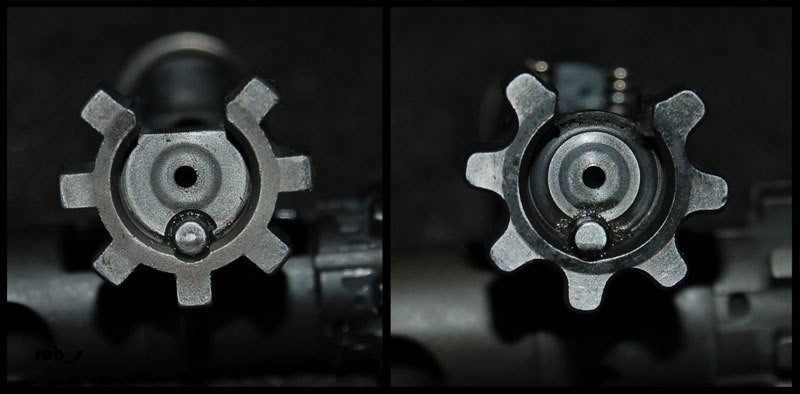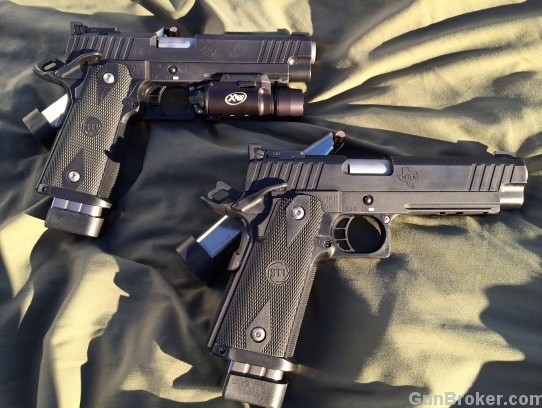If you’re a regular reader, you’ll no doubt remember my project gun from last winter, a CZ P-09 in .40 set up for USPSA Limited. You can read about the process here, or carry on to the next paragraph, where I’ll sum up the changes.
The Changes, Summed Up
The C-Zed, as I’ve been calling it, looks pretty much like a CZ P-09 externally. The only notable change is the Dawson Precision sights, a blacked-out rear unit and a fiber-optic front sight. As I’ve repeatedly complained, they may be Dawson sights, but they sure aren’t Precision. It took half an hour of filing to get the rear sight in, and because Dawson uses the least-stainless steel they can get their hands on, it’s already rusty less than a year in. Hopefully the Rustoleum in the garage will take care of it.
Internally, most of the original parts are gone in favor of Cajun Gun Works gubbins. The upshot is that the trigger, in single-action mode, is crisp, resets quickly, and weighs in at about 2.5 pounds. That’s in the ballpark of tuned 1911 trigger weights, although 1911 triggers are admittedly better in other dimensions. You’ll also note magazine extensions and a magazine well funnel, courtesy CZ Custom. On the belt, the gun rides in a race holster from Cook’s, with a Tek-Lok attachment thing1.
The Match
The match in question was at a local Western Pennsylvania gun club, and featured six stages. The first two were both hoser stages to one degree or another, with a large number of close-in targets, and a focus on leaning around barriers to hit targets otherwise inaccessible. Since I’m a young buck by the standard of the average club-level competitive shooter, the leaning and running plays to my advantage, as does the ability, when presented with a close target, to shove the gun in its direction and pull the trigger twice really fast. The next two were a bit more cerebral, with longer-range targets and some arrays which could be attacked from multiple positions. The last two were classifiers or classifier-like stages: a two-position classifier with six paper targets, and a three-string Virginia count stage with some strong hand only and weak hand only shooting.
Notes from the Range
The CZ’s trigger, as mentioned, is now pretty darned good. I can pull it twice really fast. As such, I set a new personal best for hit factor on the very first stage I shot in Limited2. I set my prior hit factor record of 6.34 on a no-movement burn-it-down classifier stage with the M9. On a move-and-shoot stage with 16 targets3, I ran the CZ to a 6.35. In fact, on three of the six stages, I notched hit factors greater than 5, which corresponds to an average of about one hit to the center of a target per second4. Although I made a mental error on the classifier stage, I was still fast enough to score a C rating, which is always my baseline goal for a new gun or division.
In general, I scored sufficiently well to beat a Production shooter I’m usually neck and neck with. Some of that may have to do with the more generous scoring for major power factor5. We’ll look into that a bit later with the match results.
I did run into one problem, which is most likely a shooter issue more than a gun issue. One-handed shooting is an old nemesis of mine. In this case, it wasn’t that the shooting was hard6, it was that the CZ repeatedly failed to feed, slowing me down and throwing off my place-keeping on the Virginia count7 stage. I suspect I was simply not giving it enough locked wrist and elbow, which I intend to verify at the range, or the next match if I can’t make it out to shoot before then.
Turning now to the belt and holster, I am entirely satisfied. The cheapo Midway belt is entirely up to the task of holding up a loaded CZ and spare magazines. The one downside is that, between the inner and outer belts, it’s quite fat, which reduces the amount of room you get for offsets.
The holster, the competition kydex model from Cook’s, did its job, besides the afore-footnoted out-of-spec offset. (That’s on me, anyway.) The adjustable retention did its job; the gun comes out buttery-smooth, but the holster still grips it enough to keep it from falling out. I’d be interested in a drop-only piece with no offset and maybe a bit of reverse cant, but such a thing does not appear to exist. On the other hand, kydex sheeting is cheap, and a simple drop is going to be pretty straightforward to fabricate. A project for the future, perhaps.
Conclusions
Match Performance
Lastly, let’s talk match results. How did I do, both overall and compared to other comparable shooters with Limited widebody 1911s? Did I perform meaningfully better than I did with my Production gun, accounting for the difference in scoring?
Overall, I placed 52nd of 92 shooters, a middle-of-the-pack finish, which isn’t surprising. I’m very much a middle-of-the-pack shooter. Since last summer was pretty busy, and the last match I shot last year was all classifier stages, we have to go back to May 2017 to find a comparable match: club-level competition, a single classifier, and a number of longer stages. In that match, I was 32nd of 40, scoring 34.37% compared to the match winner. This time, I scored 59.59%. If I hadn’t scored a goose egg on one of the stages, I likely would have come in ahead of a pair of Open shooters in my squad.
How about in my division? Surprisingly, despite blowing a stage altogether, I still managed 14th out of 30 Limited shooters8. I scored 65% of the Limited winner’s points. I’d have to cross-check more closely than I have time to, but I think it’s fair to say that most of the widebody 1911 shooters beat me, which is to be expected. Most of them have been doing this for more than one season. Again, if I had managed some points on my zero stage, I might well have moved up as high as 11th.
Scientific Testing
Now, though, we come to the interesting mathematical part. How good is my gun? How much better is it than my Beretta? Well, we can compare hit factors. My hit factor over the entire match with the CZ was 4.049. My hit factor over the comparable match with the M9 was 2.47. Clearly, the CZ is the winner!
Not so fast. The CZ benefits from major scoring. If we rescore my CZ match with minor scoring, my hit factor drops to 3.6810. In addition to the fascinating result that major power factor is worth about 10% over minor, this suggests that the CZ is definitely better than the Beretta.
Just a minute, though! I’m most likely a much better shooter in April 2018 than I was in May 2017, by dint of focused practice and a number of matches. What we really need is a benchmark. Which we have. We’ll call him L. He also shoots USPSA in western Pennsylvania, and last year, when I was shooting in Production with him, we were neck and neck through several matches. Luckily, L was at the match last weekend, still shooting Production. Presumably, he’s also been improving. So, his full-match hit factor? 3.22.
Worth It?
At this point, I think I’m finally comfortable saying the CZ improves on the Beretta by somewhere between 0.5 and 1.0 points per second, independent of more generous scoring as well as my changing competence. Of course, that figure is mainly of academic interest. “This gun is better, independent of the conditions in which it’s used,” is not a statement with a lot of practical application. The true test was this: with the CZ, am I faster than the people that I should be faster than? The answer is yes. The CZ passes with flying colors. As poor-man’s-Limited guns go, I think you’d have a hard time doing better11.
- I bought it with a drop-offset bit between the Tek-Lok thing and the holster, which drops the gun to a questionably legal height—the back of the magazine funnel just barely clears the top of my belt—and offsets it to a flagrantly illegal three or three and a half inches from the inner belt. Oops. Happily, the local match let me off with a warning. ↩
- USPSA scoring is a bit arcane even to the initiated. It goes like this. For each stage, you have a number of points based on where you hit your targets (up to a maximum of 5), and a time. Your hit factor is simply your points divided by your time. (It’s easier to think of it as points per second.) Each stage is worth a certain number of match points. The shooter with the best hit factor on a stage gets the full amount of match points from it. Other shooters get a percentage of the full amount of match points, based on the ratio of their hit factors to the fastest shooter’s. ↩
- All else being equal, a longer stage is harder to score a high hit factor on than a shorter one. In particular, a longer stage requires reloads and movement. ↩
- This is a little misleading, because there’s usually some dead time in moving and reloading. ↩
- Power factor: the weight of the bullet in grains, multiplied by the velocity in feet per second, divided by 1000. Greater than 165 (one way to get there is a 165-grain bullet at 1000 feet per second) is major. Less than that is minor. Minor scores 5 for an A zone hit, 3 for a B/C zone hit, and 1 for a D zone hit. Major scores 5/4/2. ↩
- Well, it was hard, but that wasn’t the issue. ↩
- Virginia count is a scoring mechanism where you’re penalized for extra shots and extra hits. ↩
- Many of whom were shooting minor, however, especially those who didn’t score as well as me. Out of the thirty shooters, four minor shooters scored ahead of me, and only three major shooters scored behind me. Read on, however, to see how big an advantage that actually is. (I don’t know yet. I haven’t written it up.) ↩
- The numbers in the next few paragraphs ignore misses and penalties, because, for a given stage, online-scoring system Practiscore only reports the raw point totals, ignoring misses, no-shoots, and procedurals. As long as I calculate everything the same way, I think the comparison is still valid, even given the different reloading requirements. ↩
- I’m going to ignore reloads here. On any legal USPSA stage, the Production magazine limit doesn’t really matter; you can reload while moving between arrays. ↩
- If parvusimperator ever wants to try a Limited Glock, we might see how wrong I am. ↩

